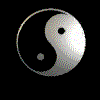 Yang, Lu-chan was born in 1799 [2]. At the age of 10 Yang, Lu-Chan became an indentured servant in the household of a Chen family member in Honan province, China [4]. It was common for the poor to sell the services of children to the rich during this period of Chinese history. Yang was lucky to have lived in a harmonious household and studied Chen Chuan (Chen boxing) with the famed 9th generation master Chen, Ch'ang-hsing [1]. He was hard working and studied Tai Chi along with other family members. It was not uncommon for servants to be trusted members of the family [4]. Yang was released from his bond at age 40 when his household master died. The master's wife and Yang were of the same age and to have a widow and servant living together under such conditions was not acceptable to the family [4]. Yang returned to his home town of Kuang P'ing and went to work in a herb shop owned by his deceased master's family in a building owned by the Wu family. Wu family members were enthusiastic martial artists as well as influential scholars. Yang was their teacher but they also sought training from the Chen family directly. It is recorded that they studied the Chao Pao style from Chen, Ching-ping and eventually created Wu style Tai Chi. Yang became well known for his combat abilities during this period and through the influence of the Wu family was appointed teacher to the Imperial court in Beijing [4]. China was ruled at this time by Manchus from the north under the Ching Emperors. The Han population thought of Manchus as foreigners and invaders. The Ching dynasty period was constantly marked by Han rebellion. So, it was in Manchu interest to keep an eye on Han martial artist of high caliber. Yang had gained a reputation for his ability to defeat other boxers but his methods were difficult to understand. Being well known and the teacher at the Imperial court posed a dilemma for Yang. He could teach the Manchus the deeper art of Tai Chi or he could modify the art to quench the courtiers desire for martial recognition and good health [5]. In The Tai Chi Boxing Chronicle by Kuo, Lien-ying it is said that an easier form of Tai Chi was taught the Imperial court because the courtiers and their family members were not willing to practice diligently and because the Yang family (Lu-chan, first son=Pan-hou, and second son=Chien-hou) were Han Chinese and not willing to teach the Manchus the deeper method of the art.
Yang, Lu-chan was born in 1799 [2]. At the age of 10 Yang, Lu-Chan became an indentured servant in the household of a Chen family member in Honan province, China [4]. It was common for the poor to sell the services of children to the rich during this period of Chinese history. Yang was lucky to have lived in a harmonious household and studied Chen Chuan (Chen boxing) with the famed 9th generation master Chen, Ch'ang-hsing [1]. He was hard working and studied Tai Chi along with other family members. It was not uncommon for servants to be trusted members of the family [4]. Yang was released from his bond at age 40 when his household master died. The master's wife and Yang were of the same age and to have a widow and servant living together under such conditions was not acceptable to the family [4]. Yang returned to his home town of Kuang P'ing and went to work in a herb shop owned by his deceased master's family in a building owned by the Wu family. Wu family members were enthusiastic martial artists as well as influential scholars. Yang was their teacher but they also sought training from the Chen family directly. It is recorded that they studied the Chao Pao style from Chen, Ching-ping and eventually created Wu style Tai Chi. Yang became well known for his combat abilities during this period and through the influence of the Wu family was appointed teacher to the Imperial court in Beijing [4]. China was ruled at this time by Manchus from the north under the Ching Emperors. The Han population thought of Manchus as foreigners and invaders. The Ching dynasty period was constantly marked by Han rebellion. So, it was in Manchu interest to keep an eye on Han martial artist of high caliber. Yang had gained a reputation for his ability to defeat other boxers but his methods were difficult to understand. Being well known and the teacher at the Imperial court posed a dilemma for Yang. He could teach the Manchus the deeper art of Tai Chi or he could modify the art to quench the courtiers desire for martial recognition and good health [5]. In The Tai Chi Boxing Chronicle by Kuo, Lien-ying it is said that an easier form of Tai Chi was taught the Imperial court because the courtiers and their family members were not willing to practice diligently and because the Yang family (Lu-chan, first son=Pan-hou, and second son=Chien-hou) were Han Chinese and not willing to teach the Manchus the deeper method of the art.| As a result, we have two distinct styles of Yang Tai Chi today, plus, a vast array of related Tai Chi forms. The most common Yang form seen practiced is derived from the Beijing style; the form related to the one taught at the Manchu court. Beijing style Tai Chi was made popular by Yang, Chen-fu (son of Yang, Chien-hou) in the 1920s. The other is Yang Kuang P'ing |



